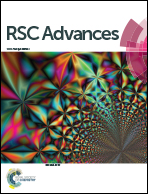The dual-stimulated release of size-selected cargos from cyclodextrin-covered mesoporous silica nanoparticles†
Abstract
A drug delivery system of dual-stimulated release of size-selected cargos from β-cyclodextrin-covered mesoporous silica nanoparticles was prepared. Calcein loaded mesoporous silica nanoparticles (MSN) were capped by β-cyclodextrin (β-CD) through photocleavable moieties to control its release. Then the small size cargo p-coumaric acid (CA) was loaded. The cavity of β-cyclodextrin was blocked by ferrocene through the host–guest interaction between the ferrocene and β-cyclodextrin. The small cargo can be released by the escape of ferrocene under +1.5 V electro-stimuli. Calcein molecules could not pass through the cavity of the β-cyclodextrin due to its bigger size. The calcein was released from the MSN after the detachment of the β-cyclodextrin cap from the MSN surface with UV irradiation. Fluorescence spectra demonstrate that different sized cargoes were released successfully step by step under external UV-light and electro stimuli respectively.


 Please wait while we load your content...
Please wait while we load your content...